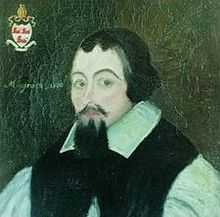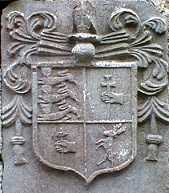Clan McGrath (Clann Mac Craith)

The Clan McGrath (Irish: Clann Mac Craith), is an Irish Clan and recognised as such by Clans of Ireland. The name has its origins in Thomond (Irish: Tuadhmhumhain), a kingdom that existed before the Norman invasion in the area of North Munster. The most notable King of Thomond was Brian Boru (Irish: Brian Bóruma Mac Cennétig) c. 941 - 1014 and it is traditionally held that the Clann MacCraith was a name bestowed upon the descendants of Brian's brother Ahearne. The Clan McGrath is thus a Clan of the Gaelic Irish tribe of the Dalcassian (Irish: Dal gCais). The Clan McGrath held a special place for themselves as hereditary poets and bards among the Dalcassian and served Brian and his descendants, the O'Brien princes of Thomond. The link to Brian Boru and the Clan O'Brien is perhaps best illustrated in the medieval period by the adoption of the three heraldic lions of the Clan O'Brien into the arms of the Clan McGrath.[1]
From its foundations in Thomond the Clan McGrath established two main Septs, one in Ulster in an area known as Termonmcgrath, that incorporates the counties of Donegal, Tyrone and Fermanagh. The other main Sept is located in Waterford, Wexford and Tipperary and straddles Munster and Leinster.
Tearmann hMacCraith
Termonmcgrath (in gaelic: Tearmann hMacCraith) Termonmcgrath (also known as Termonmagrath) exists in the Barony of Tirhugh in South Donegal. The territory incorporates the modern town of Pettigoe and the ancient pilgrimage island and lake of Lough Derg. Termonmcgrath is also home to Castle McGrath (also known as Termon Castle). To the north of the McGrath territory and just outside Ballybofey is Carraig McGrath, the inauguration site of the McGrath Chieftains(in gaelic: Ceann Fine). The Clan McGrath were the hereditary Corabs of the famous pilgrimage island of Lough Derg and controlled the routes to the pilgrimage island and the revenues gained from pilgrims making their way from across Europe to the site. The Annals of Ulster detail the names and lineage of the McGrath Chieftains of Ulster from the 12th century until the eventual confiscation of McGrath lands and disposation of the Clan McGrath by the Cromwellian government in the 17th century. This valuable source also gives information on the Termon. The Termon was under the divine protection of the local Saint Davog (Dabhog) and the hereditary Chieftain. We find the annals describing this Termon as Tearmann Dabhog (St. Davog's Termon) until the end of the 15th century when in 1496 the Annals of Ulster begin to refer to it as Tearmann Mhic Craith (McGrath's Termon) from the Clan who held the hereditary lordship and office of Corab (in gaelic: Comharba).
Archbishop Miler McGrath 1523 - 1622

Perhaps the most infamous of the McGraths of Termonmcgath is Bishop Miler McGrath (1523–1622). Miler was the son of the McGrath Chief, Donncha and was destined for the religious life. He became a Franciscan and spent some time in Rome where he acquired the bishopric of Down and Connor. Although kinsman to the Gaelic Lord, Shane 'The Proud' O'Neill, Miler was a master in the game of politics and alliances. In 1569 he conformed to the reformed faith and was granted the Protestand bishopric of Clougher, thus holding a Roman Catholic and Protestant bishopric at the same time. This continued until 1580 when he was eventually deprived of the Catholic bisopic for heresy.
Miler would eventually expand his influence and power across Ireland and became Archbishop of Cashel in Tipperary. Miler brought 200 armed men from his ancestral home at Termonmcgrath, consisting mainly of his McGrath kinsmen. Their descendants are still found today in Co. Tipperary. Miler patrolled his lands in Tipperary, carrying a sword and wearing armour, a sign perhaps of the dangers a man such as he found himself. Miler married Amy, the daughter of the O'Meara Chieftain and fathered four sons and two daughters.
In 1622 aged 100 years Miler died. Prior to his death he commissioned his tomb stone which bore his effigy in the robes of a Catholic Bishop, it is a tradition that Miler converted back to the Catholic faith before his death. Perhaps most interestingly from a heraldry point of view, Miler also had carved on his tomb stone, the Arms of his house. These are re-created in the above artwork. You will note the heraldic antelope rampant, at the bottom right hand corner. This is somewhat different from the modern interpretation of the McGrath Arms we see reproduced today. Miler's Arms are the earliest depiction of the McGrath Arms that we know of and are almost 500 years old.[2]
Annals of Ulster and Annals of the Four Masters
From the 13th century the story of the Termon has been the story of the Clan McGrath. The first Chieftain and Comharba is recorded in 1290. The following is the recorded McGrath Chieftains of Termonmagrath compiled from the ancient Annals of Ulster and the Annals of the Four Masters.

1290 - Giolla Adhamhnain MacCraith, Comharba of Terman Dabhoig died. (Nicholas MacCraith inherits title)
1340 - Nicholas MacCraith, the Comhraba died.(Muiris MacCraith inherits title).
1384 - Lucia, wife of Muiris MacCraith Comhraba dies. (Mark son of Muiris inherits title)
1423 - The MacCraith of the Termon (Chieftain) Mark, Son of Muiris dies. (Sean Mor, inherits title)
1435 - The MacCraith of the Termon, Sean Mor died; a gentlemen who maintained a house of hospitality for all. (Matthew, Sean's brother inherits the title)
1440 - The MacCraith of the Termon, Matthew son of Mark died. (Sean Bui 'the fair haired' son of Sean Mor inherits the title)
1463 - Torlough, son of Mark MacCraith died.
1465 - Art, son of Sean Mor MacCraith and dean of Lough Erne Deanery, died.
1469 - Sean Bui, son of Sean Mor died. (Diarmuid son of Mark, son of Muiris inherits title)
1470 - Catherine, wife of Diarmuid MacCraith died.
1491 - Rory son of Diarmuid MacCraith becomes Comharba and inherits title. Diarmuid is gravely ill.
1492 - The MacCraith of the Termon, Diarmuid, son of Mark, son of Muiris died.
1499 - Grainne wife of The MacCraith, Rory died this year.
1504 - Andrew son of the Chieftain of the Termon died, "And there was not, during his lifetime in Ireland at that time a Termoner's son that had greater respect and honour and kept a better house of hospitality than he".
1507 - Donncha MacCraith at this time was Prior of Lough Derg.
1524 - Sean Bui, son of Andrew MacCraith a man of most esteem and influence in Ulster, died.
1527 - William, son of Andrew MacCraith, a man of wealth who kept a house of hospitality for all, and his wife both died within one day and one night.
1528 - The MacCraith of the Termon, Rory son of Diarmuid, son of Mark, died, "And a noble Chieftain was that man, and he was generous to strangers, intelligent, informed, cheerful and virtuous. And he was a learned antiquarian and a man that kept a general guest house among Ulstermen". (Torloug, son of Andrew McGrath inherits title).
1538 - Annabel, daughter of The MacCraith died.
1542 - The MacCraith of the Termon, Torlough son of Andrew, died.
1549 - Fr. Brian Bocht MacCraith OFM, noted preacher and miracle worker, native of the Termon, died in Donegal Friary. This is also where Miler McGrath began his ecclesiastical career.
1562 - The MacCraith of the Termon died. (Donncha MacCraith inherits title).
1593 - Petition of Archbishop Miler McGrath for the surrender of the Termon lands of his Father to Queen Elizabeth I.
1596 - On 5 May, Donncha MacCraith, "Chieftain of Termon McGrath, surrendered all his Termon lands to the Queen for reduction to English tenure and re-grant to himself and his Clan. On the 13th May the same lands were re-granted to Donncha by Queen Elizabeth I. These included all the lands of Termonmagrath as well as the lands of Termonnamongan. These lands spanned three counties and the diocese of Clougher and Derry."
1603 - Chieftain of Termonmagrath, Donncha MacCratith died. (James, son of Donncha inherits title).
1610 - James McGrath esq, Chieftain and Lord of Termonmagrath receives title of lands from King James I of England, VI of Scotland.
1641 - Castle McGrath comes under siege by the Lagganer's, a force of northern Protestant settlers who oppose the Catholic Confederacy. The Clan McGrath burn the castle rather than let it be used as a military post by the Protestant forces. The lands of Termonmagrath are confiscated and the Clan McGrath are disinherited.[3][4]
The Ulster McGrath Chieftains 1290 - 1641
Giolla Adhamhnain MacCraith
Nicholas, son of Giolla MacCraith,
Muiris son of Nicholas MacCraith
Mark son of Muiris MacCraith
Sean Mor son of Muiris MacCraith
Matthew brother of Sean Mor MacCraith
Sean Bui 'the fair haired' son of Sean Mor MacCraith
Diarmuid son of Mark, son of Muiris MacCraith
Rory son of Diarmuid, son of Mark MacCraith
Torlough, son of Andrew MacCraith
(Unknown MacCraith Chieftain between 1549 and 1562)
Donncha MacCraith
James, son of Donncha MacCraith
James, son of James MacCraith
References
- ↑ http://www.imecofarm.com/McGrath_Clan_Origins_Thomond_Clare_Imecofarm.htm
- ↑ Pettigo And Its People by John Cunningham
- ↑ http://www.ucc.ie/celt/online/T100001A/
- ↑ http://www.ucc.ie/celt/published/T100005A/
- ↑ Pettigo And Its People by John Cunningham